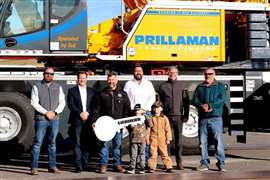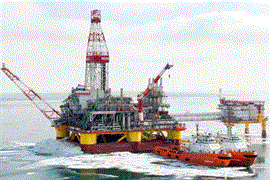Exploring the expanding market for telescopic crawler cranes
01 October 2024
Telescopic crawler cranes are known for their versatility, ease of transport and ability to mobilise quickly and work on various terrains. They are popular for highway and bridge jobs, performing powerline work and as assist cranes on wind farms. The market for this type is strong and manufacturers see potential for even more business.
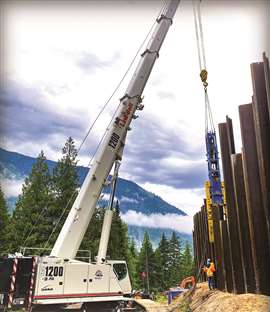 Link-Belt TCC 1200 Lifting capacity: 110 tonnes Main boom: 12.2 to 45.7 metres Fixed jib: 10.7 to 17.7 metres Maximum boom and jib: 63.4 metres Counterweight: 37.2 tonnes
Link-Belt TCC 1200 Lifting capacity: 110 tonnes Main boom: 12.2 to 45.7 metres Fixed jib: 10.7 to 17.7 metres Maximum boom and jib: 63.4 metres Counterweight: 37.2 tonnes
Telescopic crawlers are becoming a fleet favourite because they are easy to mobilise and operate. Manufacturers offering telecrawler cranes include Link-Belt, Liebherr, Grove, Tadano and Sany. ICST’s sister publication American Cranes & Transport reached out to those five for their insight into the current market and their latest models.
Heating up
The market for telescopic crawlers has been consistent with some modest growth expected year over year, according to Link-Belt. This is expected to continue through the remainder of 2024.
“Demand is highest for our larger-class models, the 120 US ton [109 metric tonne] cranes and up,” says Brian Elkins, product manager, lattice and telescopic crawler cranes, Link-Belt Cranes. “This includes our 120 ton TCC-1200, 140 ton [127 tonne] TCC-1400, and 250 ton [227 tonne] TCC-2500. The lower-tonnage classes are still a popular option for smaller projects but they’re just not as high in demand as the larger models. TCCs continue to replace traditional lattice boom crawlers in bridge construction, as they can handle the needs of larger fixtures and bridge beams at greater radius with better efficiency.”
The TCC-800 is a staple in rental fleets for pick-and-carry tasks in general construction and is also favoured by foundation contractors, Elkins says. Telecrawlers are ideal as a support crane, handling rebar cages and for other applications where clearance is tight and mobility is limited.
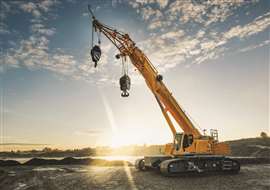 Liebherr LTR 1150 Lifting capacity: 150 tonnes Main boom: 52 metres Fixed jib: 18.9 metre folding jib and-or 2.9 metre assembly jib Maximum boom and jib: 85 metres Counterweight: 22 tonnes, plus superstructure counterweight: 41 tonnes
Liebherr LTR 1150 Lifting capacity: 150 tonnes Main boom: 52 metres Fixed jib: 18.9 metre folding jib and-or 2.9 metre assembly jib Maximum boom and jib: 85 metres Counterweight: 22 tonnes, plus superstructure counterweight: 41 tonnes
“Since their introduction in 2017, large-capacity telescopic crawler cranes like the TCC-2500 have consistently demonstrated their value,” Elkins adds. “From the outset, customers recognised the advantages of models like the TCC-1400 and the TCC-2500. These larger cranes have played a crucial role in the green energy sector, particularly in wind projects, making them an essential part of the industry.”
When purchasing telescopic crawlers, Link-Belt customers are always looking for versatility. Elkins says. In general construction customers regularly need to move underneath bridge overpasses. The ability to retract the boom, travel below and extend the boom to be back to lifting mode in just minutes is a huge advantage over a traditional lattice boom crawler.
While Link-Belt is expecting this sector to remain mostly consistent, there is also certainly room for growth. “As more and more contractors, crane rental houses and owners and operators see the value of it, they start finding more uses,” concludes Elkins. “Telecrawlers cover a lot of ground and add an extremely versatile crane to any fleet. Ground preparation, for example, is much less of a concern than with a traditional outrigger crane.”
Elkins says Link-Belt’s smaller capacity telecrawlers are still in demand, particularly the 55 ton (50 tonne) TCC-550 and the 80 ton (73 tonne) TCC-800, with the TCC-800 being especially popular.
Optimum capacity
The market is a diverse one covering many applications, including wind, road and bridge, petrochemical, tilt wall construction and more.
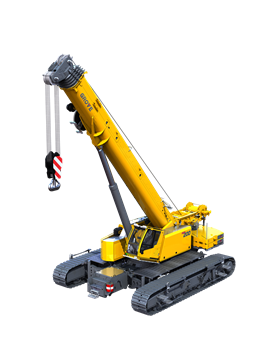 Grove GHC 200 Lifting capacity: 181.4 tonnes Main boom: 15.4 to 68 metres Fixed jib: 11 metres Maximum boom and jib: 88.1 metres Counterweight: 65 tonnes
Grove GHC 200 Lifting capacity: 181.4 tonnes Main boom: 15.4 to 68 metres Fixed jib: 11 metres Maximum boom and jib: 88.1 metres Counterweight: 65 tonnes
“We see a strong push in multiple markets within the USA including green energy, infrastructure, data centres and distribution centres,” says Beau Pocock, business development manager, rough terrain cranes, and product specialist all terrain and telecrawler cranes in the mobile and crawler crane division at Liebherr USA. “Within these various sectors the market demand continues to grow for a more flexible, compact machine with a strong chart and easy transport such as the newly developed Liebherr LTR 1150.”
Liebherr offers its VarioBase feature to provide greater safety for telescopic mobile cranes, and allows for significantly higher load capacities, especially for lifts directly over the supports. The LTR 1150 is the first telescopic crawler crane to have this system, which determines the optimum load capacity in real time, depending on the fixed track width and the variable rotation angle. The greatest advantages in terms of load capacity are achieved when performing lifts over the corners of the tracks, especially on reduced track widths. The maximum track width of 5.8 metres, a reduced width of 5 metres and a narrow 3.5 metre track width are available.
“For the first time for Liebherr telescopic crawler cranes, we have also calculated WindSpeed load charts for the new LTR 1150, making it possible to work safely and flexibly even at high wind speeds,” said Pocock.
Nimble navigation
Manitowoc will begin shipping its largest Grove hydraulic crawler (GHC) telecrawler crane – the new GHC200 – to customers later in 2024. Featuring a 200 ton (181 tonne) capacity and 56.4 metre main boom, the new model is said to deliver heavy-duty lifting power in applications that require high capacity at various radii in tough job site conditions, such as swampy and mountainous terrain.
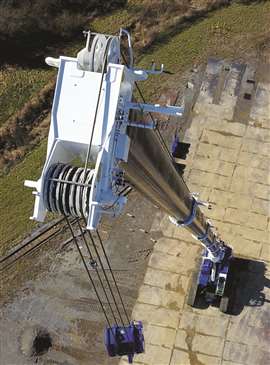 Tadano GTC 1600 Lifting capacity: 160 tonnes Main boom: 13.1 to 61 metres Fixed jib: 18 metres Maximum boom and jib: 93 metres Counterweight: 31.8 tonnes
Tadano GTC 1600 Lifting capacity: 160 tonnes Main boom: 13.1 to 61 metres Fixed jib: 18 metres Maximum boom and jib: 93 metres Counterweight: 31.8 tonnes
The GHC200 was unveiled to dealers and customers at Manitowoc’s Crane Days event in May at the company’s factory in Shady Grove, Pennsylvania, USA.
“We have seen substantial growth within our telecrawler offerings, and our new model launches continue to contribute to this success,” says JJ Grace, product manager for GHC cranes at Manitowoc. “One market trend we have seen is the growth and demand for larger telecrawlers. To meet this demand, the GHC200 is our latest and largest telecrawler offering.”
Typical applications for Grove telescopic crawlers include utility work or lifting work on infrastructure projects, Grace says. “Users really like how our GHC cranes combine the advantages of a fast telescopic boom that would typically feature on a wheeled mobile crane, with the stability of a crawler crane and the ability to cover rough ground,” adds Grace.
Grove’s GHC series is for customers who need a compact, manoeuvrable crane designed to withstand the rigours of merciless terrain. With minimal transport requirements, 100 per cent pick-and-carry ability, and a telescoping boom, these cranes have proven nimble in both getting to and navigating jobsites, says Grace.
When it comes to unique applications, Manitowoc has seen its telecrawlers assist with barge work (barge charts are standard), pile driving and foundation jobs. “One of the latest is an assist crane on a wind farm to build some of our Manitowoc MLC product,” says Grace. “Then, they stayed on the job to do pick and carry work or even used a tailing crane.”
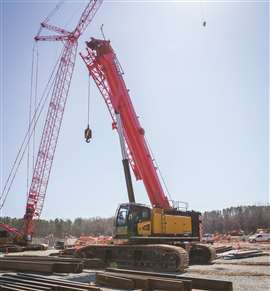 Sany SCA1600TB CAPACITY OF CRANE: 160 tons MAIN BOOM LENGTH: 42.4 feet to 196.5 feet FIXED JIB LENGTH: 9.8 feet to 50.9 feet BOOM LENGTH WITH JIBS: 196.5 feet + 50.9 feet COUNTERWEIGHT: 79,400 pounds upper + 22,000 pounds carbody
Sany SCA1600TB CAPACITY OF CRANE: 160 tons MAIN BOOM LENGTH: 42.4 feet to 196.5 feet FIXED JIB LENGTH: 9.8 feet to 50.9 feet BOOM LENGTH WITH JIBS: 196.5 feet + 50.9 feet COUNTERWEIGHT: 79,400 pounds upper + 22,000 pounds carbody
Finding its footing
While the market has been growing with a shift to the larger capacity models, the Tadano GTC-1600 and GTC-2000 (145 and 181 tonne capacities, respectively) are immensely popular, the company says. The smaller capacity telecrawlers in the Tadano line also see steady demand.
“Our customers like the telecrawlers for their ease of operation, transportability and pick-and-carry capabilities,” says Allen Kadow, product manager, telescopic and lattice crawler cranes at Tadano America. “We believe the market will continue to strengthen as customers discover the many applications that these cranes perform perfectly in.”
Regarding replacement, the telescopic crawler is less of a commodity crane than RTs and smaller lattice products. These cranes and their quality tend to stand the test of time and remain working in fleets for a number of years, according to Tadano.
This crane family has really found its footing in foundation work, bridge and heavy civil, commercial projects and powerline construction and maintenance, Kadow said. They also perform well in the wind industry, supporting the large lattice crawler cranes used for turbine erection, as well as in marine and railroad applications.


